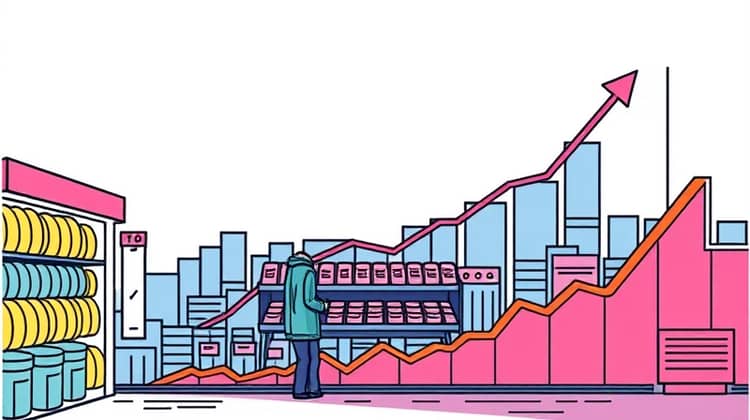Understanding how inflation affects loans is crucial for anyone looking to borrow money in today’s economy. Price increases can lead to significant financial strain on consumers, but they also influence the borrowing landscape in various ways. By knowing the ins and outs of inflation and its impact on loans, you can make informed decisions that protect your financial interests.
What is Inflation?

Inflation occurs when there is a general increase in prices, leading to a decrease in purchasing power. This phenomenon can be caused by various factors, including increased demand for goods and services, rising production costs, or excessive money supply in the economy. Understanding inflation is key to navigating the economic environment and making sound financial decisions.
There are different measures of inflation, including the Consumer Price Index (CPI) which tracks the price changes of a basket of goods and services over time. This index is critical for economists and policymakers as it provides insights into the cost of living and economic stability.
Inflation can have both positive and negative effects on the economy. While moderate inflation is often seen as a sign of a growing economy, excessive inflation can disrupt financial markets and decrease consumer confidence.
- Inflation reduces the purchasing power of money.
- It can increase interest rates on loans.
- Inflation affects savings and investments.
In summary, inflation is a complex economic measure that affects everyone. Its impact extends beyond consumer prices and can significantly influence various sectors, including loans and borrowing.
How Inflation Affects Loans

When inflation rises, it typically leads to higher interest rates, making loans more expensive for borrowers. Lenders increase interest rates to protect themselves against the eroding value of money and to maintain their profit margins. As a result, borrowers will find that their monthly payments are higher during inflationary periods.
Moreover, the impact of inflation is not uniform across all types of loans. Different loans react differently to inflation, depending on their structure, terms, and the economic environment. Understanding these differences can help borrowers make more informed choices.
- Higher interest rates increase loan payments.
- Inflation can impact loan availability.
- Borrowers may choose different types of loans based on inflation trends.
Overall, inflation significantly impacts loans and consumer financial planning, creating challenges and opportunities for borrowers.
Types of Loans and Inflation

Understanding the types of loans available and how they relate to inflation is critical in today’s economic landscape. Different loans are influenced by inflation in various ways, and being aware of these distinctions can help borrowers select the best option for their circumstances.
1. Fixed-Rate Loans
Fixed-rate loans offer borrowers a stable interest rate for the duration of the loan term. This stability can be advantageous during periods of inflation, as monthly repayments remain predictable and do not change over time. Borrowers who secure a fixed-rate loan during low inflation could benefit from favorable terms, especially if inflation rises subsequently.
However, during high inflation periods, the fixed interest rates may be lower than the current market rates. This situation can mean that borrowers are essentially paying less relative to the inflation-adjusted value of their loan, which can be a cost-saving advantage.
Additionally, fixed-rate loans can serve as a hedge against future inflation, as borrowers lock in lower rates now, protecting them from potential rate increases later on.
- Predictable monthly payments.
- Protection against rising interest rates.
- Potential cost savings if inflation rises.
Overall, fixed-rate loans offer certain benefits during inflationary periods, but borrowers should also consider their long-term financial strategies when pursuing this loan type.
2. Variable-Rate Loans
Variable-rate loans have interest rates that fluctuate based on market conditions, often tied to an index rate. Because these loans are susceptible to rate changes, they may carry risk, especially in periods of rising inflation. As inflation leads to increased interest rates, borrowers with variable-rate loans could find their payments becoming significantly more expensive over time.
In an inflationary environment, the initial lower rates of variable loans can be appealing; however, if rates increase, borrowers can face high payment adjustments that add financial pressure. Therefore, understanding market dynamics and potential future inflation is crucial when considering these types of loans.
Ultimately, variable-rate loans can offer flexibility and potentially lower initial costs, but borrowers must be prepared for the possibility of rising costs that can accompany inflation.
- Interest rates can fluctuate dramatically.
- Monthly payments may increase as rates rise.
- Initial low rates may deceive borrowers about true loan costs.
In conclusion, while variable-rate loans can initially seem attractive, borrowers need to carefully assess their risk tolerance and economic forecasts, especially in relation to inflation.
3. Student Loans
Student loans are particularly sensitive to inflation, especially when considering the cost of education and the burden of repayment. During times of high inflation, the costs associated with higher education can soar, leading to larger loan amounts that students must take on to finance their education.
Moreover, the interest rates on student loans can vary—some are fixed while others are variable, which means that students could face escalating payments if they choose a variable-rate option during inflationary periods.
When borrowers graduate and enter the workforce, any increase in wages due to inflation may not necessarily match the rising costs of their student loan repayments, creating financial challenges.
- Education costs may rise with inflation.
- Variable-rate student loans can become costly.
- Post-graduation wage growth may not keep pace with loan repayments.
In summary, students must weigh the implications of inflation and loan types during their education financing decisions, as it can impact their long-term financial health.
Borrowing Tips During Inflationary Periods

Navigating loans in an inflationary environment can be challenging, but there are strategies that can help. Being proactive and informed can make a significant difference in financial outcomes during these times.
- Consider locking in a fixed-rate loan for consistency in payments.
- Shop around for the lowest rates available.
- Evaluate your long-term financial goals before borrowing.
By implementing these strategies, borrowers can better navigate the complexities of obtaining loans during inflationary periods.
In conclusion

Inflation is an essential factor that influences various economic aspects, including loans. Understanding how inflation works and its effects on different loan types can empower borrowers to make sound financial decisions. With inflation impacting interest rates and economic forecasts, consumers must be strategic in their borrowing choices.
Fixed-rate loans, variable-rate loans, and student loans each have unique characteristics regarding inflation, requiring careful consideration by potential borrowers. Being aware of these differences can help individuals safeguard their finances, particularly when seeking loans.
As inflation continues to change the economic landscape, keeping informed and adaptable is vital for maintaining financial stability and achieving financial goals.














